Landing in Podgorica is an amazing experience by itself. The plane flies over the entire Montenegrin coast, from Kotor, next to the Croatian border in the north, to Skadar Lake, next to the Albanian border in the South. The main national airport looks more like an aerodrome, and customs formalities don’t take too long.
A few things before you leave! Montenegro is a stunning country with a great diversity of landscapes. Without being in the EU, the official currency is also Euro! Taking a car is a great option, as it gives you many more opportunities to explore the country where public transports are quite limited. Should you rent a car, don’t look at the distances in km but in time, as most of the roads are narrow and steep. But the most important thing would be: don’t trust the Lonely Planet Guide for this country; its advice proved to be quite unreliable. It’s better to travel by instinct rather than travel books there 🙂 It can be really cold in the mountains even in summer, while really hot at the same time near the sea! Finally – but not least, most of toilets of Montenegro are Turkish toilets, often without paper, so don’t forget your roll in your bag!

The Ostrog Monastery
The Ostrog monastery is a one-hour drive from Podgorica, the capital city of Montenegro. Take the main road in the direction of Niksic and Zabkjak, and turn right when you reach Danilovgrad, on an amazing steep and narrow road. The Ostrog monastery is a monastery of the Serbian Orthodox Church located against an almost vertical background, high up in the large rock of Ostroška Greda. It is dedicated to Saint Basil of Ostrog buried in the premises. The site offers a fantastic view 900 meters above the Zeta valley.
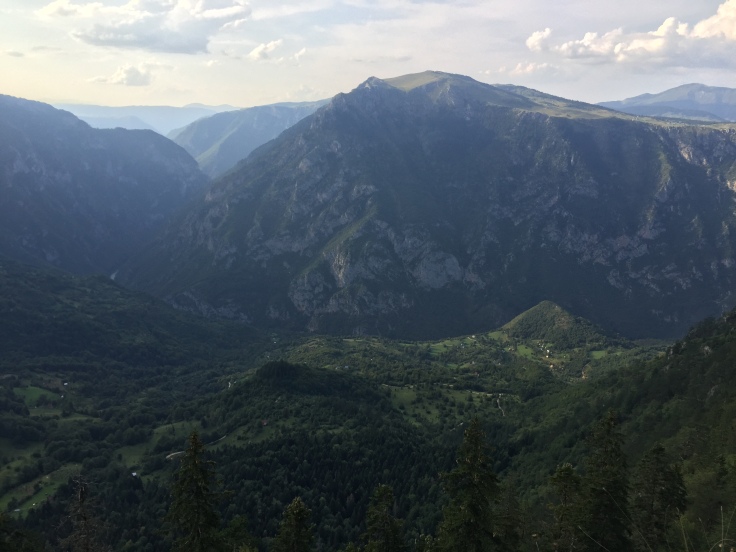
The Upper Monastery, the main and most impressive one is named ‘Sv Vasilije’s miracle’, as its construction, in 1665 within two large caves, seems to be a mystery for everyone. This is the most important site in Montenegro for Orthodox Christians, attracting up to a million visitors annually. Be careful not to mix with pilgrims while visiting the monastery; some areas are dedicated to them – going there might be putting you into an embarrassing situation.

Durmitor National Park
Leaving the Ostrog monastery behind, Zabljak was our next destination! In the middle of the Durmitor National Park, one of the monuments of Montenegro, Zabljak city is two-hour drive from the Ostrog monastery. With an altitude of 1,456m, the city is the starting point for all mountain activities in the Durmitor National Park. During winter, Zabljak is one of the most famous skiing stations within the whole Balkans.
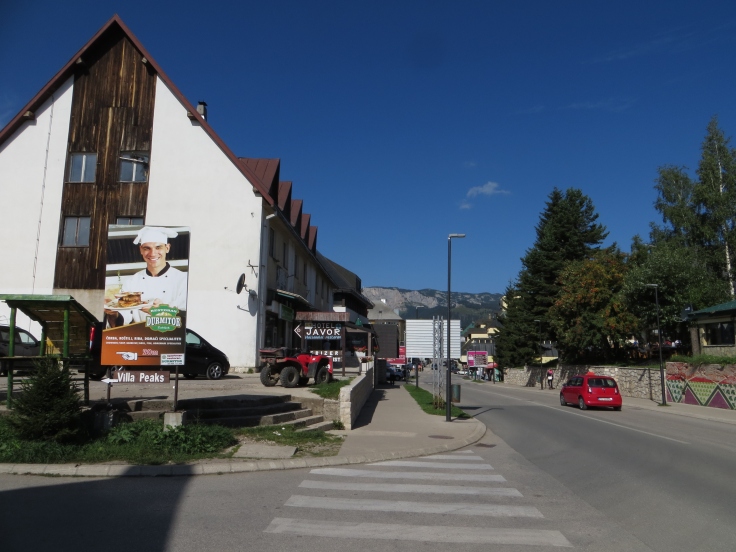
ONE PLACE TO STAY: Hikers Den in Zabljak. Great stay, friendly people.
Opened from April to October, the hostel is the place where all backpackers in the Durmitor Park converge after sunset and share their experience. If you are lucky, baby dogs will welcome you upon your arrival.
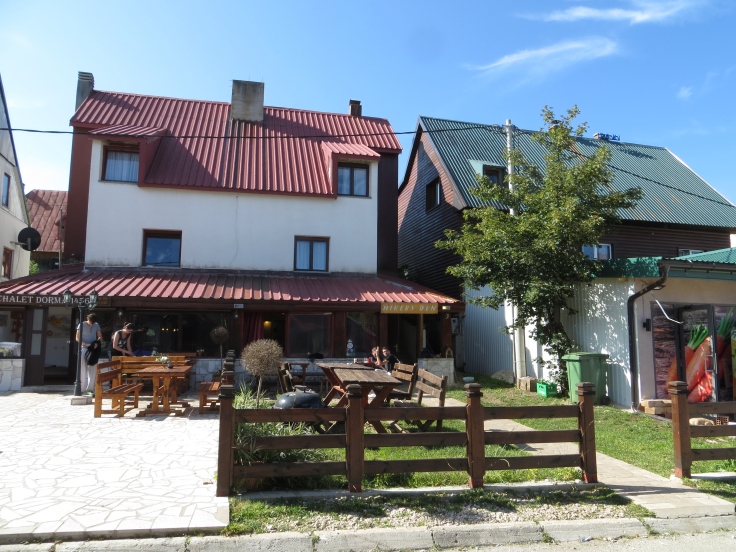
Durmitor National Park
We decided to canyon on the Tara River on Monday. From the youth hostel, Durmitours picks you up in front of the youth hostel at 8.30 sharp to take you to the Tara River! Reaching the camp takes two hours, but what a journey. To reach the camp, at the Bosnian border, the van takes the National Durmitor roads one and two. Lost in the middle of the Balkan Mountains, landscapes and viewpoints are breathtaking.
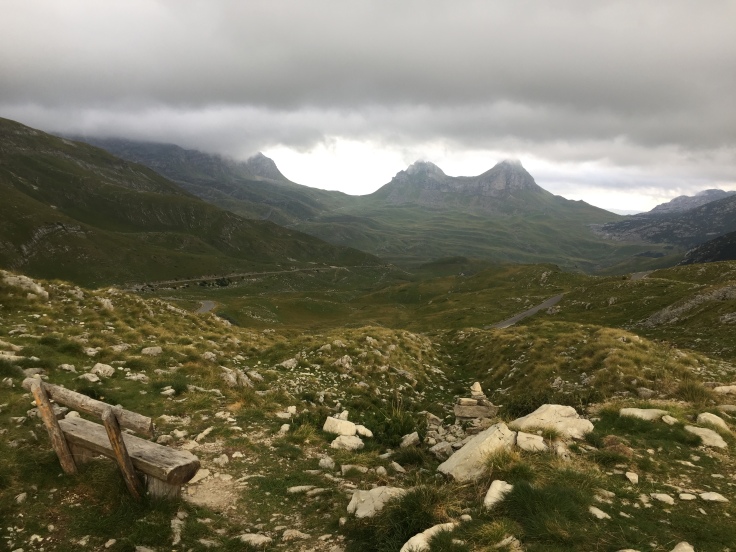
The road slaloms between various alpine pastures. The first stop is at 2,150m high, with an amazing view on the highest mountain of the Montenegro, the “Lobotov Kuk”, standing up at 2,650m.
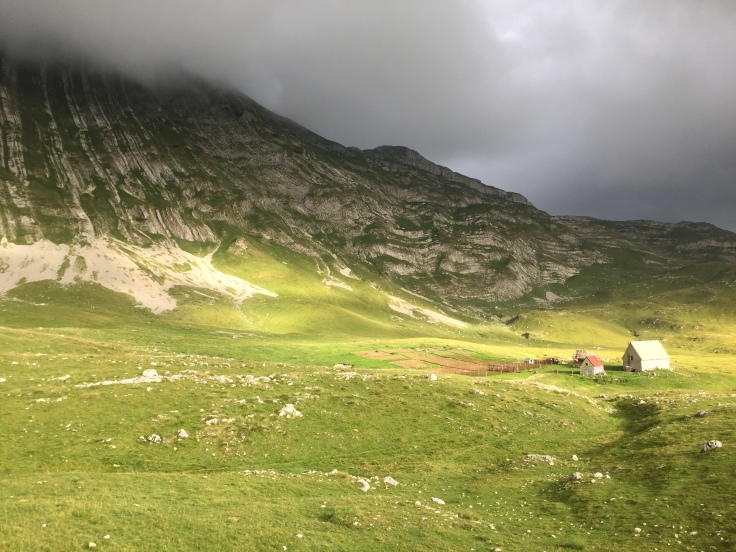
The second stop is where the highest farms of Montenegro are, with people spending there their entire winter, at the Bosnian Border. Farms are the rally point between three different valleys, which makes it quite foggy over there.
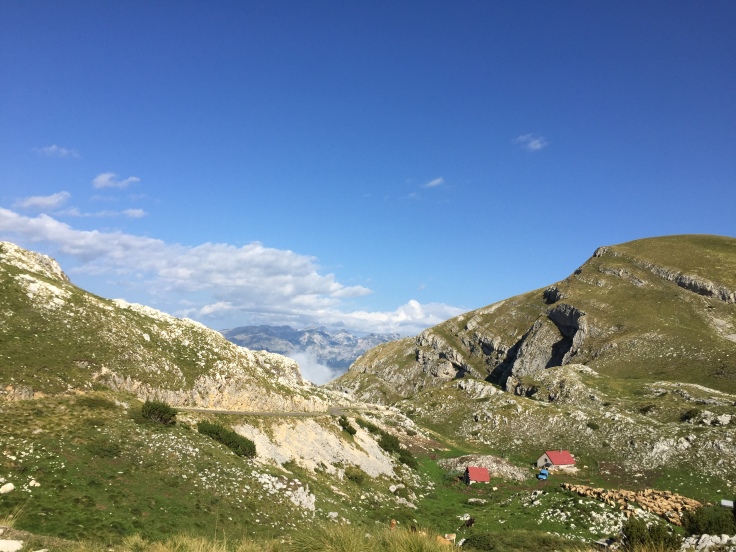
The road goes down on meadows overlooking three different valleys.

The third stop of the trip is the Piva Lake. This is an artificial lake, the biggest reservoir of the Balkans and the most elevated reservoir for drinkable water of the world. The crystal blue water contrasts with the white steep banks of the lake. Important to note, Piva means beer in Montenegrin language.

The road to the camp follows the lake. At the end of the lake, an impressive Soviet style dam closes the lake. A glance at the Piva river below makes it even more impressive. So cool!
The Tara River
After two hours driving between the different canyons of Montenegro and Bosnia, the van drops us back to the Durmitour camp. Next to the Piva River and surrounded by wooded mountains, the camp is built with a dozen of wooden chalets. Here waits for us a typical Montenegrin breakfast.
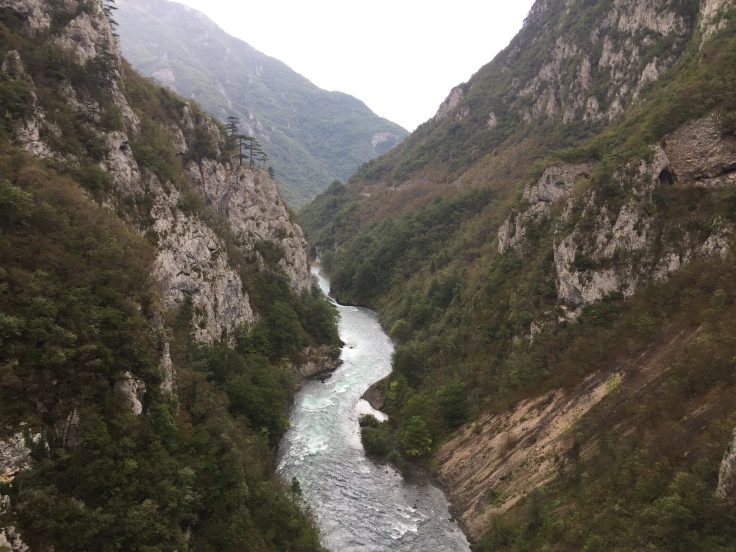
Tara River is a must-do in Montenegro. The Tara canyon is the world second biggest canyon after the Grand Canyon in the US! The Tara River snakes between wooded cliffs up to 1,300m high!
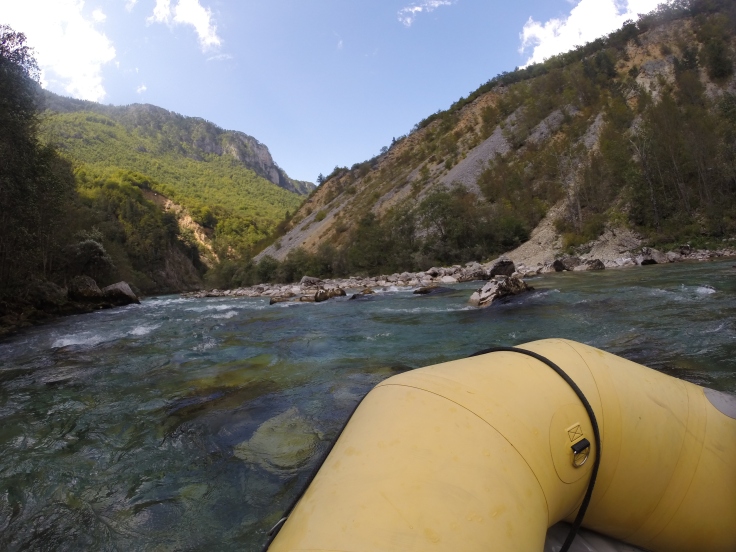
The river is the natural border between Montenegro (on your left) and Bosnia (on your right). Water is transparent and you can see the river’s bed and trouts under your raft!

Going through the Tara River takes around 5 hours, but is definitely worth it. Landscapes are changing as long as you go down, and rapids are quite amusing without being scary in summer – definitely another story in spring with the snow melt! A good way to meet other backpackers as well!
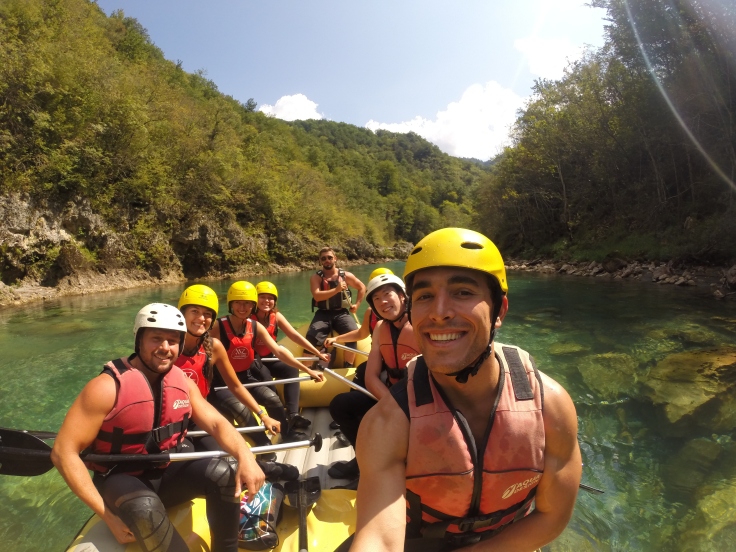
Some stops are also planned, as one for jumping into the water from cliffs overlooking the river, or another one on the Bosnian side for a break.
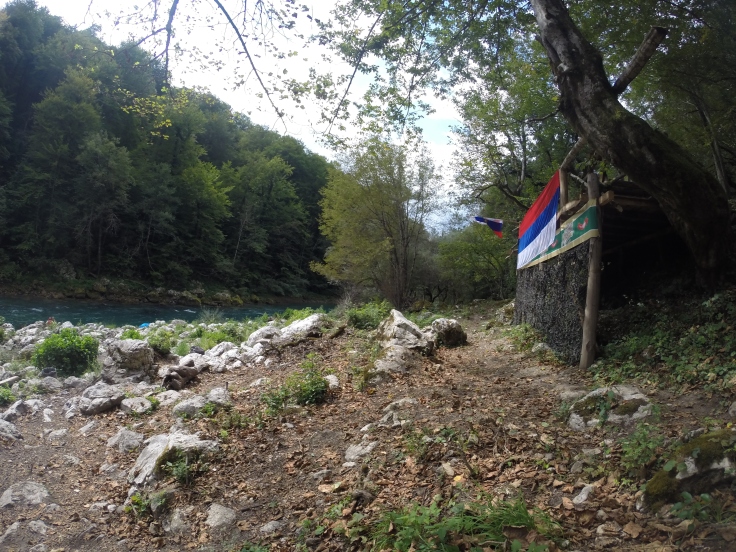
The final stop of the ride is below a wooden bridge, under the checkpoint between Bosnia and Montenegro.
Black Lake in Zabljak
On Tuesday morning, one must-do was still missing on our list before going back on the road. The Durmitor National Park hides another wonderful place: the black lake, Crno Jezero in Montenegrin. The black lake is located at 3 km from Zabljak. A 3€ fee has to be paid before entering the path leading to the lake and the park.
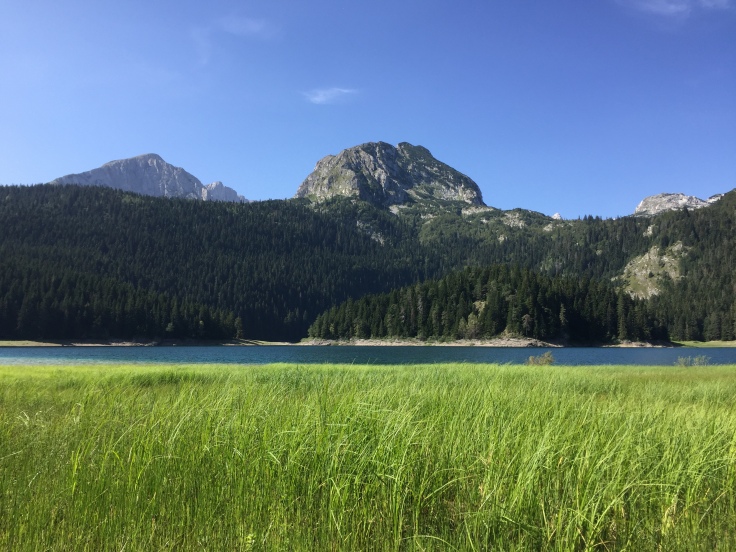
The ideal moment to go to the lake is at sunrise or sunset, as the sky is most likely clear of any clouds at that time, and also because you will most likely be alone!
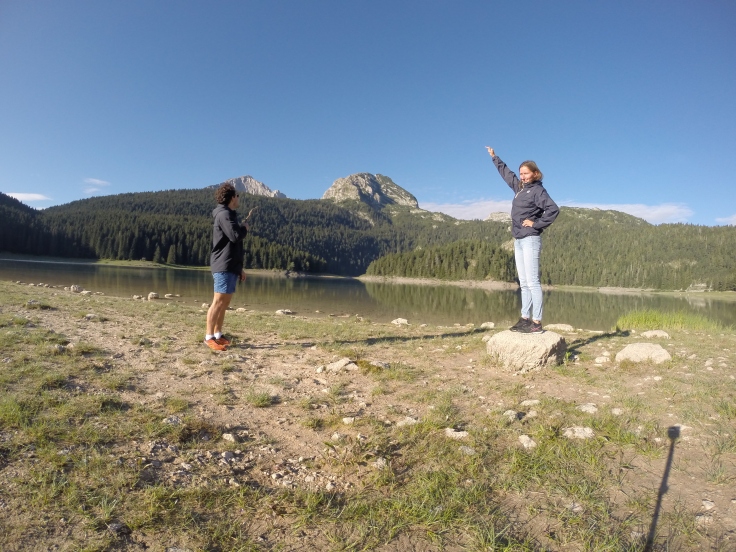
A large mountain, the Meded (literally peak of the bear in Montenegrin) overlooks the lake. Although the water is crystal clear, the reputation of black lake is due to the mountains surrounding the lake, the shadow of each of these peaks hiding the natural light of the sun at every time of the day.
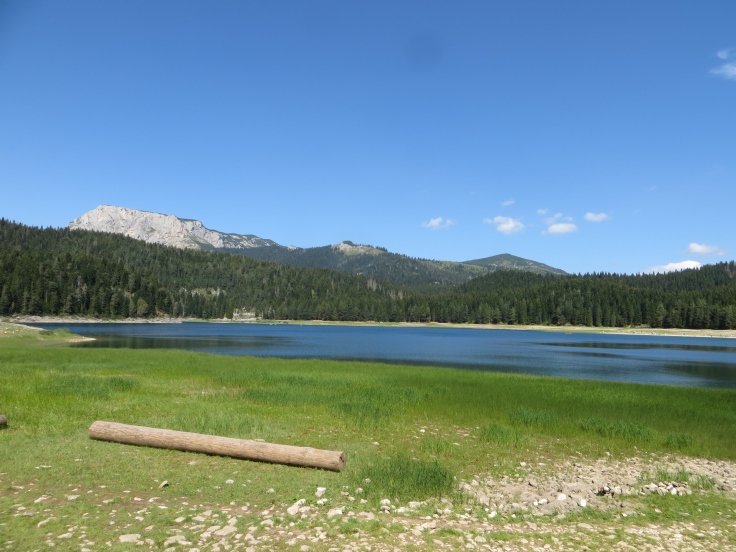
An amazing path of 4 km circles the lake and reveals different astonishing viewpoints of the lake.

The Biosphere reserve of Biogradska Gora
The road leading the biosphere reserve of Biogradska Gora, one of Montenegro’s jewels, is stunning. Zigzagging between the various mountains of the Durmitor, it offers multiple stops on both sides of the road to enjoy astonishing views. Going to the Biogradska Gora through Mojkovac takes around two hours.

In the heart of the Bjelasica mountain range, Biogradska Gora is a park of 1,600 hectares of virgin forest. This is one of the last three primary forests in Europe. En 1878, Nicolas I, the ruler of Montenergo between 1860 and 1918 loved the area so much that he enacted that it was protected and left as such. That’s why you can find in this forest trees being more than 500 years old and higher than 60 meters tall! The park counts five glacial lakes in total.
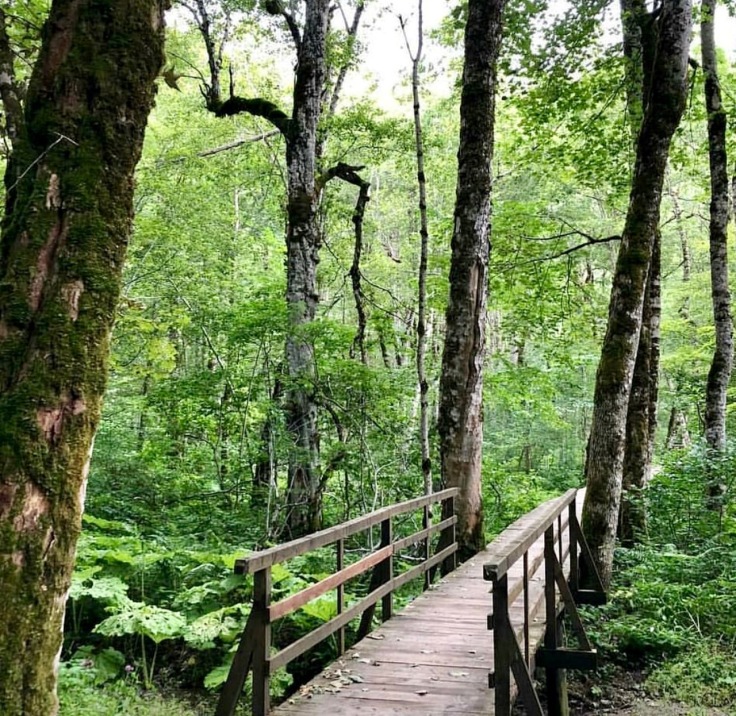
Similar to the black lake, a path follows the shores of the lake, where it is allowed to swim or rent a canoe. Embracing the quietness of the place is one of the things you should do at least once on a lifetime.

A PLACE TO EAT: Savardak, 3km from Kolasin
A few kilometers after the Biogradska national park stands Kolasin, a small city leading to the Moraca canyon in direction of the capital, Podgorica. 3 km from Kolasin, in direction of Kolasin skiing station, stands Savardak. Alongside a stream, the hay-shaped restaurant serves typical Montenegrin food. One of our favorite!

After fabulous meals with creamy cheese and polenta (our favorite), and creamy cheese and polenta, we left both Durmitor and Biogradska Gora national park by the Moraca canyon, with a stop to the Moraca monastery.
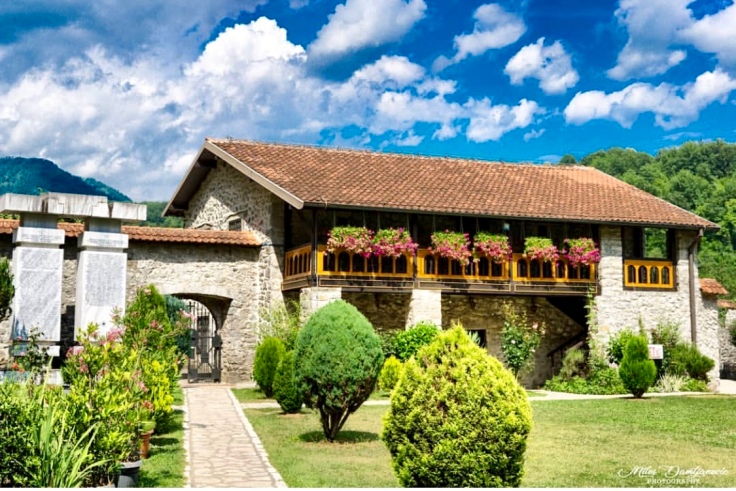
Lovcen National Park
The Moraca canyon leads to the Podgrocia valley. From there, Cetinje was our next stop! Leaving the narrow and serpentine roads for large highways in the plain, it was great to arrive at Cetinje, coiled between Lovcen Mountains.

Cetinje
Cetinje is the former capital of Montenegro, which you could have guessed from its architecture. The Art Nouveau style of the houses downtown testifies of this past glory.
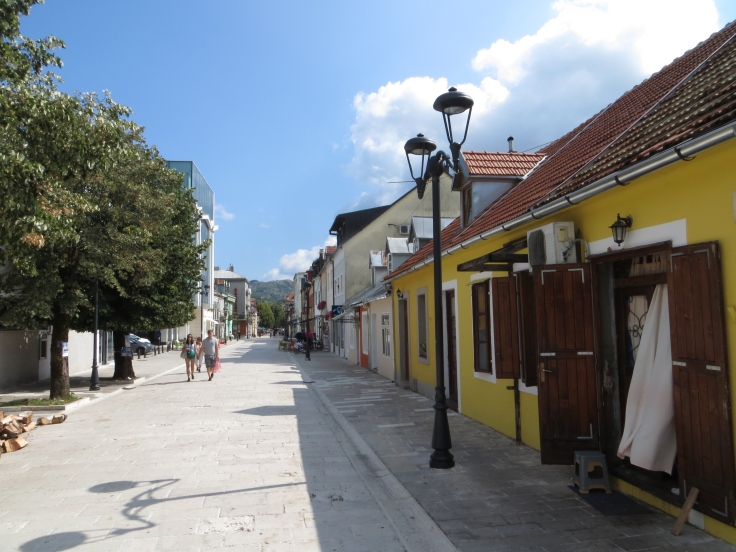
Built in 1482 and cradle of the rebellion against the Ottomans, the city gave back its title of capital in favor of Podgorica in 1946 (called ‘Titograd at the time).

As most of the cities in Montenegro, Cetinje is quite straightforward to visit. Spend some time in the city center strolling and enjoy a local beer, cheese and ham from Njegusi in the various terraces in town.
Lovcen National Park
After sunset, we took the road in the direction of the Lovcen National park, and put our tent in the middle of the forest, at the foot of Njegos mausoleum.
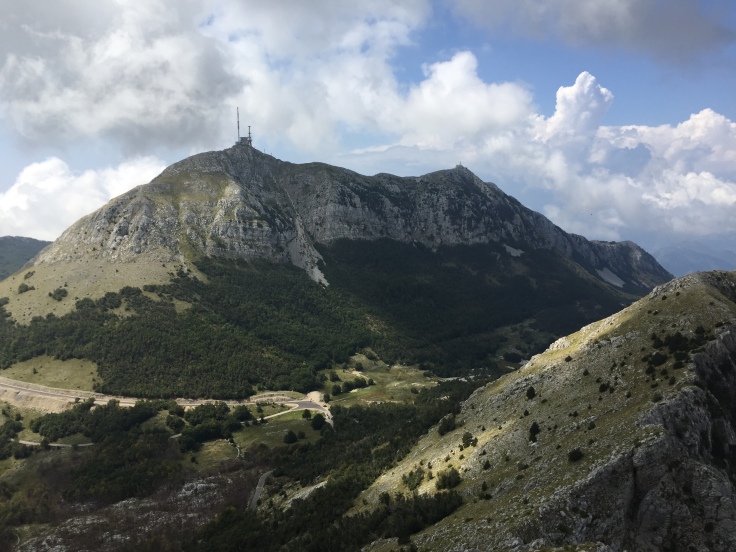
The Njegos mausoleum gives a flabbergasting viewpoint of the entire country and even beyond, from Croatia to Albania. As it opens at 8 in the morning, we were among the first ones to enter.

The Mausoleum is located right in front of the mount Lovcen, the highest mountain of the park. At the top of the Jezerski peak, the second highest peak of the Lovcen mountain chain sits the Njegos mausolee. This is the tomb of Pierre II Petrovic Njegos, poet and prince-bishop, and also national hero! The Mausolee was built between 1970 and 1974. And what a view 🙂
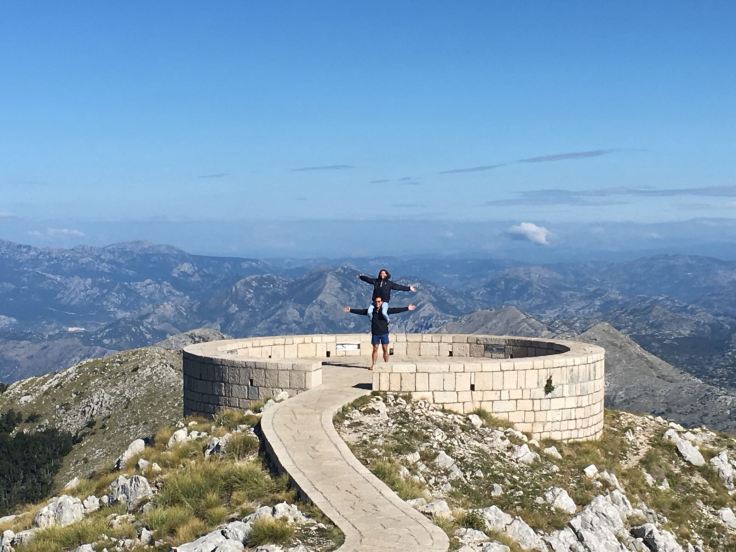
Mont Lovcen road
Leaving behind the Lovcen mountains, direction Kotor! Although the view is amazing all along the way, its serpentine reputation is not a legend!

Kotor is one of the most visited cities in Montenegro, and a lot of bus operators offer daily trips to Lovcen. At the time we were there, the road asphalt was also being re-done. In a nutshell, face to face with buses and trucks in one of the most steepened, narrow and busy road of the country can sometimes be sporty and might test your driving skills. But the view and the experience are definitely worth it!

The road from Kotor to Lovcen is long of 17km and counts no less than 25 hairpin bends. Both views at the bottom, overlooking Kotor, and at the top, overlooking the Adriatic Sea and facing the Lovcen Mountains, should leave you speechless.
The Bay of Kotor
Kotor
Kotor is obviously the most visited city in Montenegro, as attests the several ferries dropping every day thousands of tourists visiting the Mediterranean Sea. Coiled at the bottom of Lovcen, the medieval city, circled by its ramparts, is a travel through time. The town is a melting pot of Christian and orthodox churches, cobblestone streets and Venetian palaces.
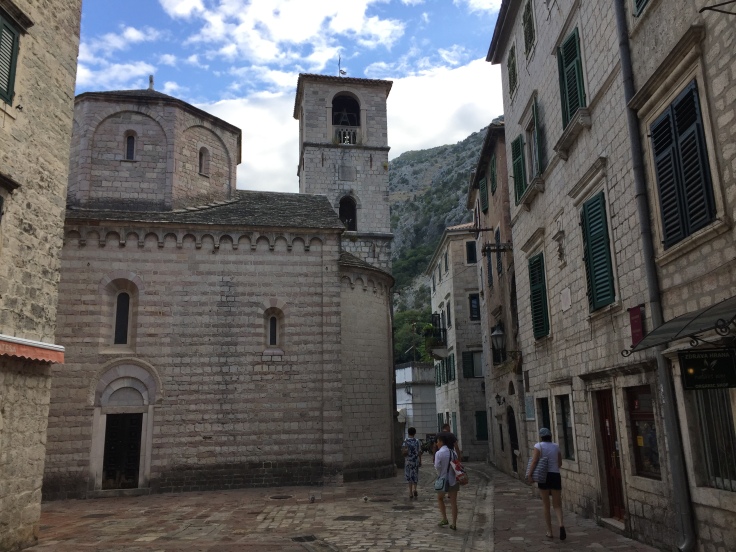
The maze of alleys of the old city dilutes surprisingly well all the visitors. Climbing the 1,500 steps to reach the fortress overlooking the city is mandatory. Although the place is not in good shape, this former castle offers quite a good panorama over the Kotor bay

In the middle of the ascent is a tiny orthodox church, giving you one of the most famous views on Kotor’s old town.

As a quite touristic city, we have no restaurants to recommend here, as we found to be disappointed by the several places we went in.
Perast
Take Venetian palaces and put them on the Kotor bay and you will get Perast. The small city lies down on the mountainside, right in the middle of the bay. Witnesses of a glorious past, Perast Main Street counts no less than seventeen palaces and sixteen churches. Although some are falling into pieces, most of them have been refreshed, and give to the city a warm sweet atmosphere with and bougainvillea smells.
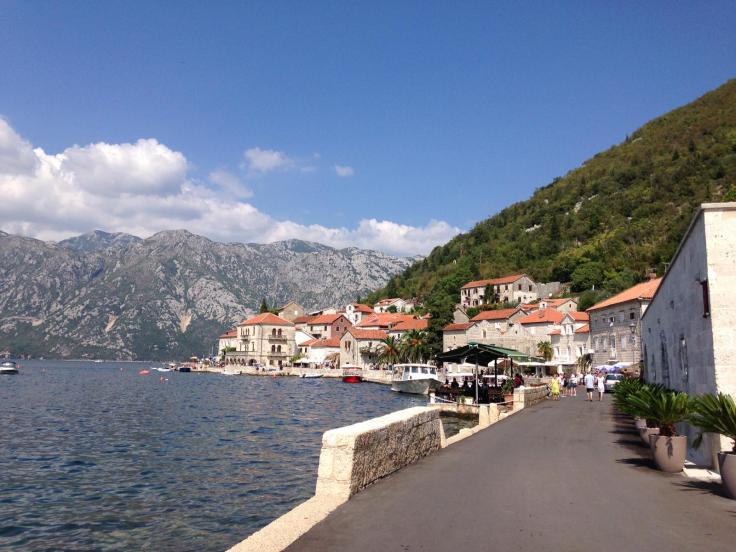
The national road circling the bay overlooks the village. Forbidden to cars, the village is organized around the main street alongside the shore, Obala Marka Martinovica. The main church, Saint Nicolas, faces the two islands, Gospa od Skrpjela and Sveti Djordje). Men created the first one in 1452 after an apparition of the virgin over the water. The church was finished in 1630 and hosts several Venetian paintings.

A THING TO DO: Instead of taking a boat with other people, take a canoe 🙂
The second island, smaller and circled with cypresses, hosts a Benedictine monastery and a cemetery. Access to this island is forbidden, but boats taking you from the city to the first island generally make the tour.

The Kotor bay, from Kotor to Perast and after is really pleasant. Beyond Perast sits Morinj, a nice and quiet village in a corner of the bay. The village is full of several campsites. We went to Autocamp Nakula, although we don’t recommend it. Other campsites, in the direction of Herceg Novi, are alongside the water, and looked much more authentic and pleasant.
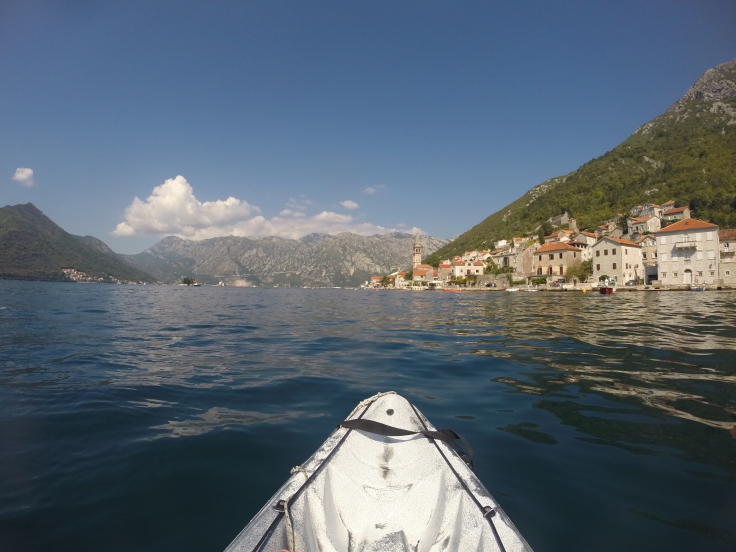
Next to Perast, less known and visited, exists a must-see for people who loved the Lascaux caves in France, with the prehistoric drawings on Lipci. 3km from Morinj, apart from the main road, a small path takes you to a cave where, above, you can spot some figures from the 8th century A.D.! Pay attention, you can’t catch them at first sight!
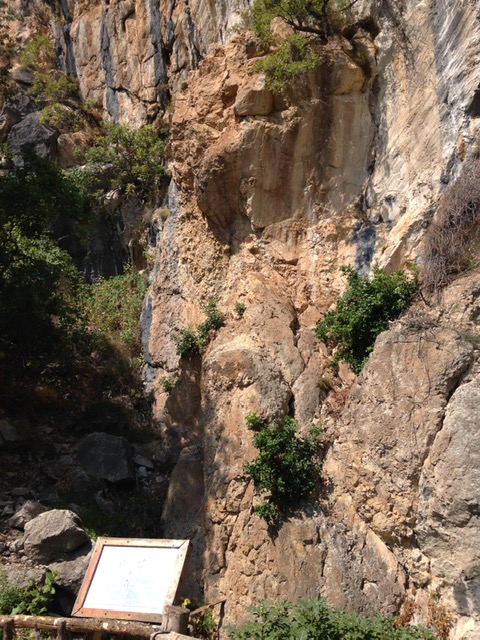
Herceg Novi
Following the Kotor bay in the direction of the Croatian border, we arrived to Herceg Novi. Herceg Novi is the closest Montenegrin city from Croatia. The old fortress dominates a large part of the city and gives a stunning overview on the Kotor gulf and around.

Although truly different from Perast and Kotor, the old city, Ulica Njegoseva, is charming. Its maze of tiled or paved alleys, its churches, its colorful houses and its echo give a soul and holiday atmosphere to the lively city.
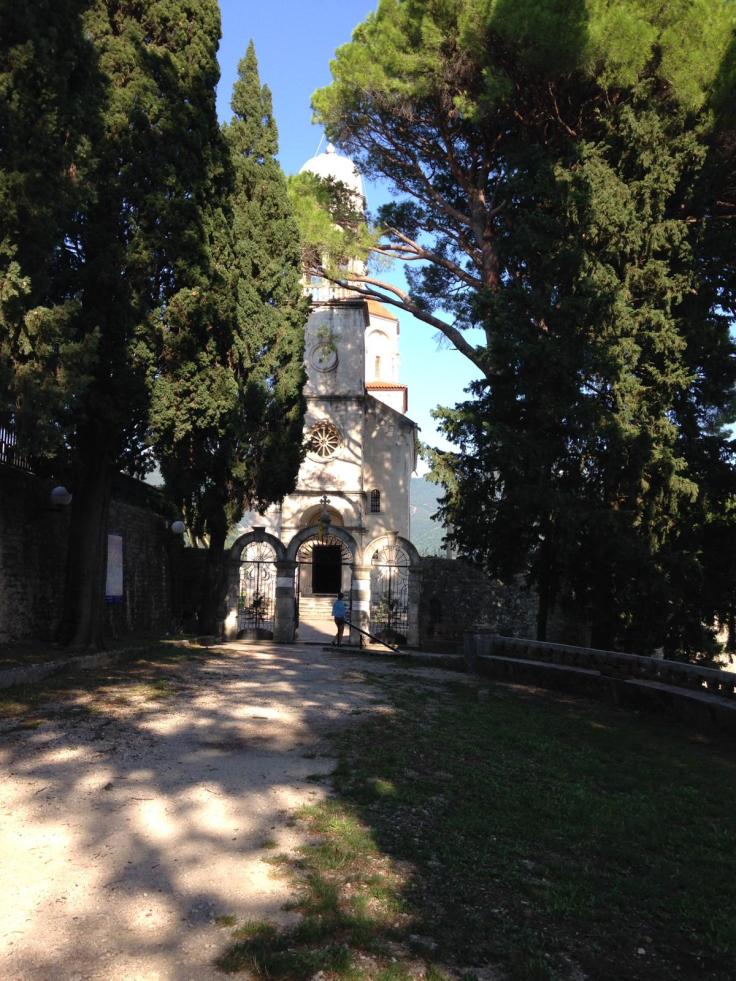
The clock tower, former entrance point of the city leads to the Trg Nikole Durkovica, which is the main place of the old town with several cafés and restaurants, and with a cute church in the middle.

One of the main assets of Herceg Novi is the Setaliste Pet Danica. A 5 km ride alongside the seafront, named after five women called Danica who died during WWII. Although the style reminds of the Soviet seaside resort with a relatively concrete-looking waterfront, the walk is nice, and follows the tracks of the train line connecting Sarajevo to the Adriatic coast built at the beginning of the 20th century.
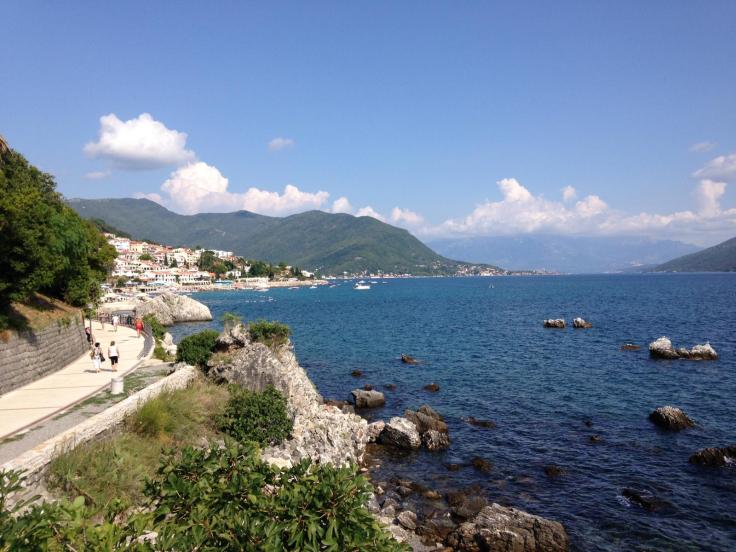
From the Forte Mare, the former prison at the top of the city, the easiest way to reach out the sea, is to take one of the many steep stairs slaloming between houses.
A PLACE TO GO: Off the beaten path, live a tasty oyster experience with a man in communion with nature

The Adriatic Cost
Unlike the Kotor bay, which is a travel through time, the Adriatic coast was sometimes disappointing. Although Sveti Stefan was nice to visit, Przno charming, and the city center of Bar cosy, Budva and Petrovac were really of no interest for us. These two towns are simply seaside resorts without charm, but concrete-made buildings and private beaches. Also, it is hard to find a decent fish restaurant, which is kind of ironic, considering the magnificent sea that lies in front. The same sentiment applies except for Ulcinj. We read a lot about the beauty of the city and its endless beaches, but also that it was a jump into Albanian culture. If the second statement is true – indeed, we can really feel the Muslim influence in Ulcinj, the first one is to some extend not true. Furthermore, the contrast is striking between local inhabitants from the south coast and the ones leaving in the mountains. We were really well welcomed in the mountains, while our experience on the coast with others was not so convincing. From our experience, the Adriatic coast is not the part of Montenegro you should focus your time on.
Sveti Stefan
Sveti Stefan is a beautiful medieval village on a small island, connected to the coast by a narrow road.
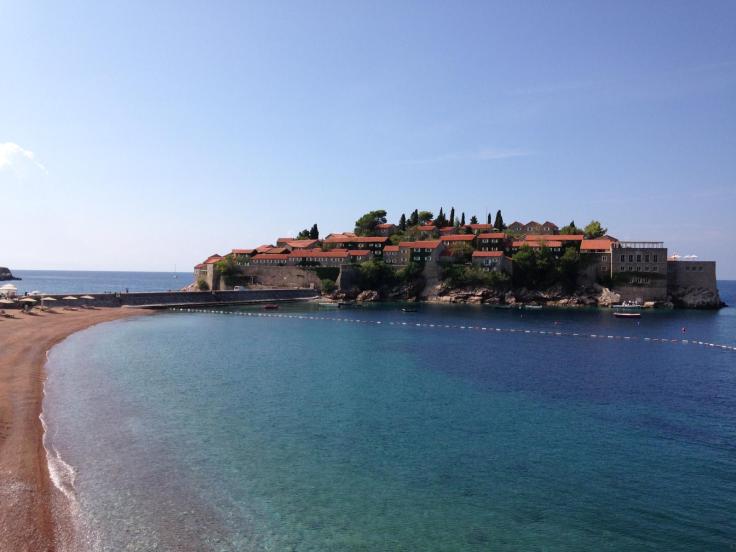
Unless you sleep in one of the hotels on the island, the island cannot be visited, as it is the property of the Aman luxury hotels group. From the coast, the view is absolutely stunning!

Our experience in Sveti Stefan was mitigated. The island and nature around is really stunning! On the other hand, the village of Sveti Stefan doesn’t show a lot of interest in itself, as it is really touristic, with restaurants that are neither typical nor friendly. The village is overcrowded with buses dropping hundreds of tourists every day which the objective of taking a picture of the island and leaving two hours after. Not really our style for sight seeing!

On the right side of the island are two beaches, one private and one public. The private beach is pretty desert, due to prohibitive costs for deckchairs. But the public one definitely does the job. Although sand was traded with shingles, the view on the island is flabbergasting, water is crystal clear, and really warm!

On the left side of the road leading to Sveti Stefan is the private beach of the island, and only reserved for hotel’s clients – a deckchair can also be rent for 60€.

However, following the rocky embankment above the beach and going up North leads to a shady path between cypresses, with a tremendous view on Sveti Stefan and crystal water. The sounds from cicadas give a lot of charm to the walk.
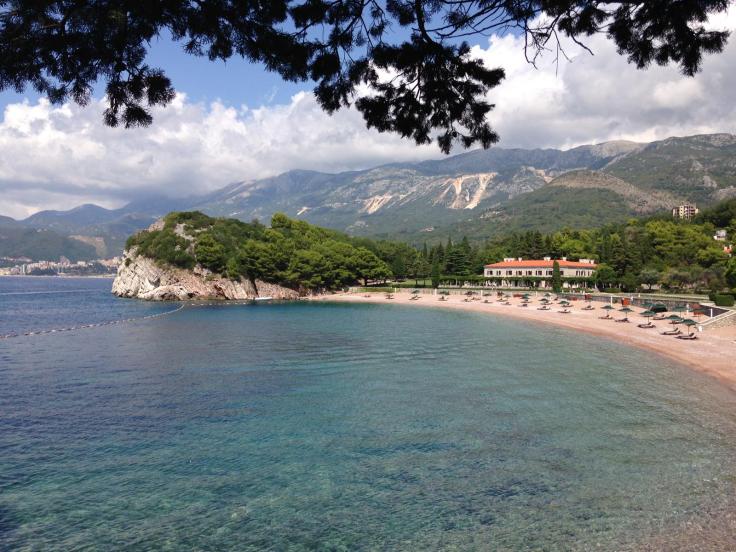
Leaving the cypresses behind, the path reaches the King beach, or Kraljeva Plaza in Montenegrin. Here, cypresses spread over the hills, leaving room to olive trees. The beach, in a bay hidden from Sveti Stefan, is covered with pink sand.

Behind sits the villa Milocer, an imposing house also property of the Aman hotel group. The villa used to be the residency of the Karadordevic, the former Serbian royal family, who ran the country in the 19th century.
Przno
The path from the villa Milocer crosses another cypresses forest, which ends at Przno! And what a crush! Unlike Sveti Stefan, Przno is really quiet, with a lot of charm. Also the public beach is really small, the littoral, full of fishermen houses, contrasts with the touristic crowd on the other side of the bay. A good catch !

Unlike Sveti Stefan, restaurants are peaceful and serve fresh fish.
A PLACE TO GO: IL BRODETTO, fish restaurant on the seafront
In a nutshell: if you plan a stop in Sveti Stefan, park your car in Przno. From there, take the path going to Sveti Stefan through the villa Milocer, enjoy the view on the island, and come back to Przno to enjoy fishermen dishes in a peaceful and typical Montenegrin environment 🙂
A PLACE NOT TO GO: Crvna Glavica Autocamp & Crvna Glavica: This camping is an opened dump!
The camping, warmly advised and suggested by Lonely Planet is an opened dump. We laughed so much when we saw this that we did not want to stop there: the road leading to the camping is a mogul field, the old couple in charge of the camping is just here to take your money. The promised view on Sveti Stefan from the Lonely Planet is correct, but from the top of a pile of garbage. Showers outside provide only cold water going out from a rusted tube. In one word: avoid!
To note, Crvna Glavica, also recommended in the Lonely, is the beach from the same camping, and shares the same “coziness” standards.
Skadar Lake
After Ulcinj and its disappointments, we went to the last hotspot before leaving the country. The Skadar Lake. The road from Ulcinj follows the Albanian border and landscapes succeed one after the other.
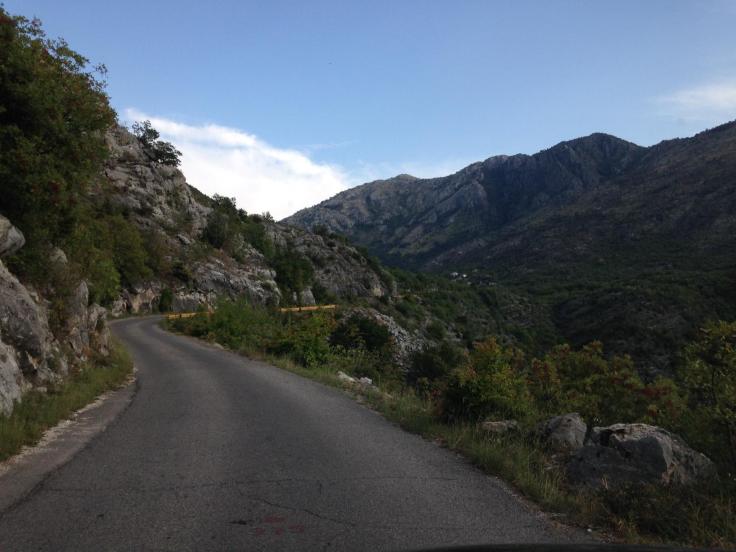
The south shore of the lake has the reputation of being the most beautiful and typical – and from what we experienced, deserved! The area, quite hilly, gives astonishing viewpoints of the Skadar Lake.
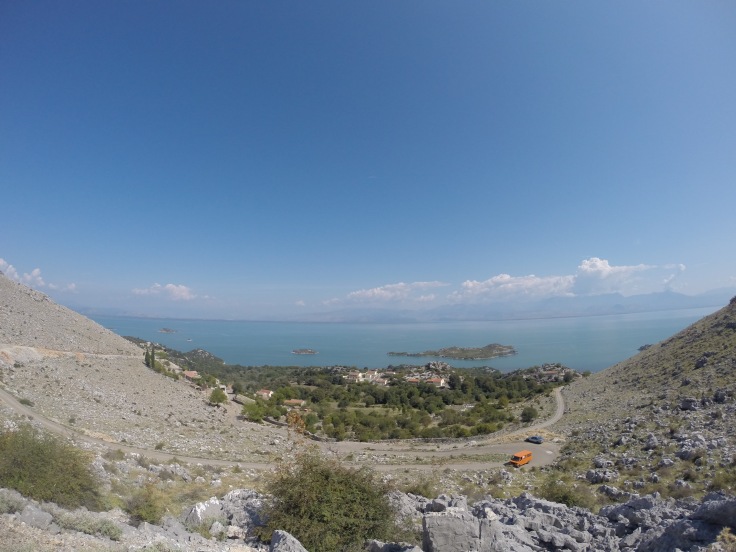
Lake Skadar is shored of small villages with a few houses, sometimes mosques, sometimes orthodox churches or both. The national park, almost desert, contrasts with the crowded Adriatic coast we just left.
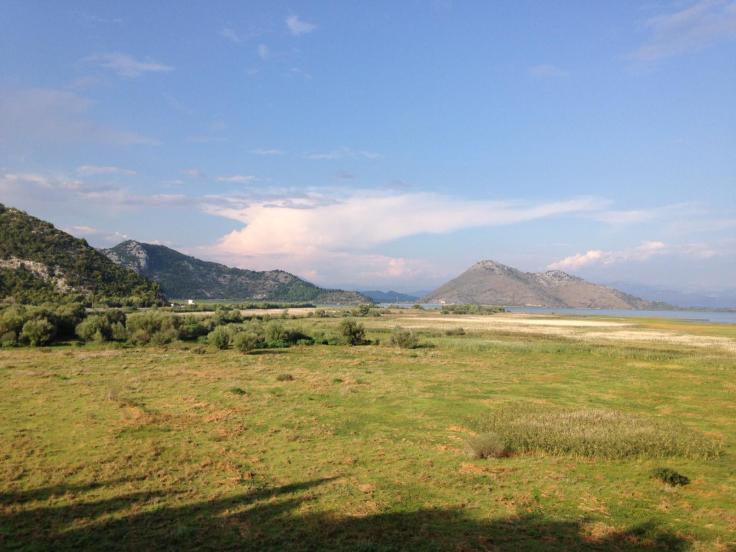
The main town of the Skadar national park is Virpazar. The majority of tours on the lake start from there. The city is very small, but restaurants alongside the river serve good carps and trouts.

Various operators offer a ride on the lake, the ideal is to choose among them depending on what you want to do, the time you have for it and what you want to spend.
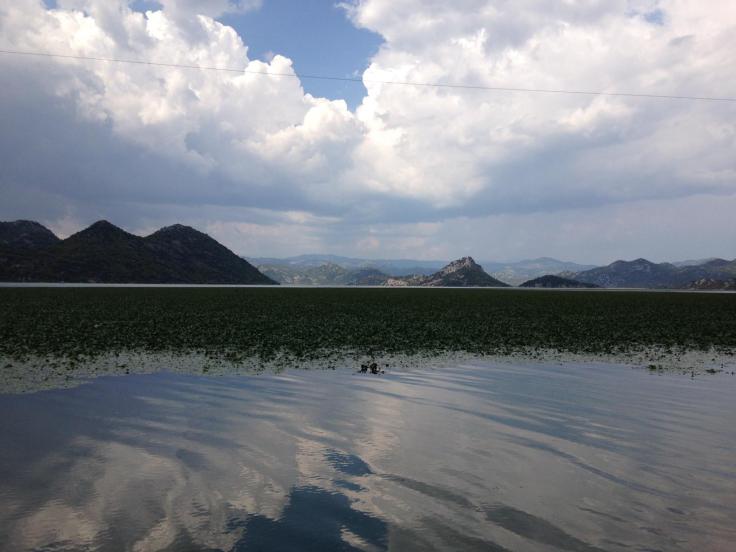
Boats usually take people to the North part of Skadar Lake, where the lake ends. This was a great experience! The boat goes through water lilies, and mountains at the end remind of Vietnam Ha Long Bay or Guangxi region in China.
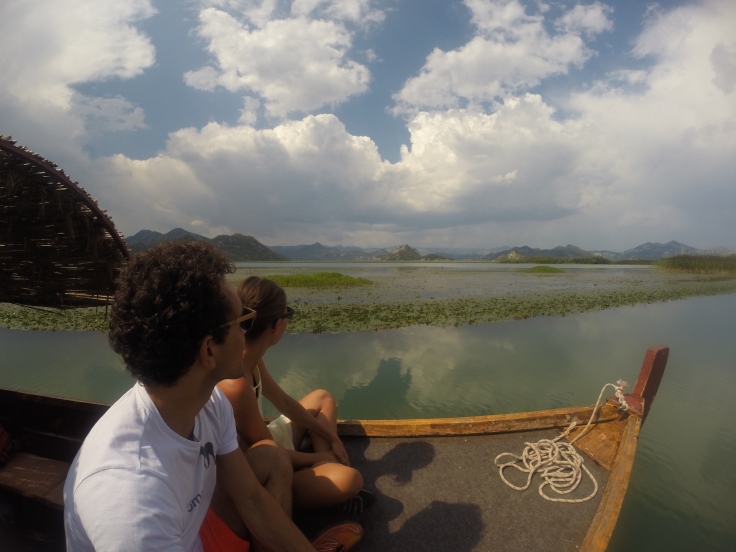
The tour lasts for more than two hours but it’s surprising how many different things you can see in such a small amount of time!

Murici is one-hour drive from Virpazar. It is a small village where we decided to stay, as the view, from the shore of the islands and Albania on the other side, is said to be flabbergasting!
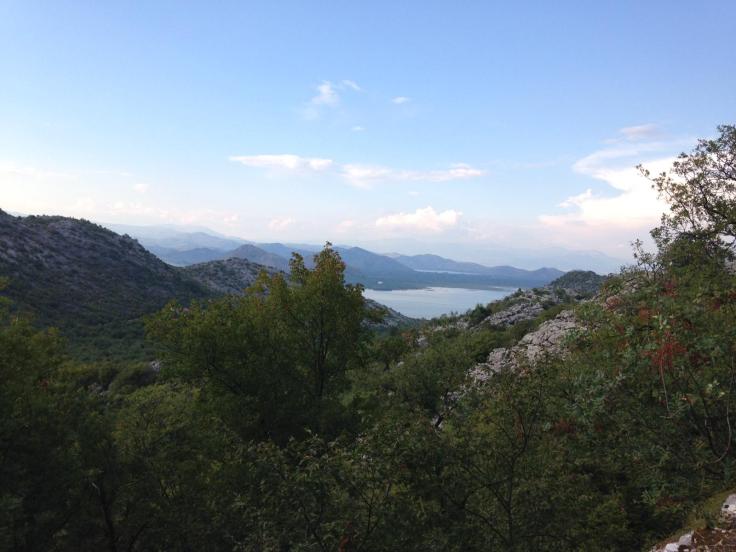
A PLACE TO STAY: Camping Murici. Great and quiet camping on the shore of Skadar Lake, fresh fish and magic landscape – we even stayed one more night.
The camping was really one of our favorite spot during our stay in Montenegro. The place is idyllic. In the middle of the Skadar National Park, beautiful birds fly above your head, while you are enjoying the calmness of the place.
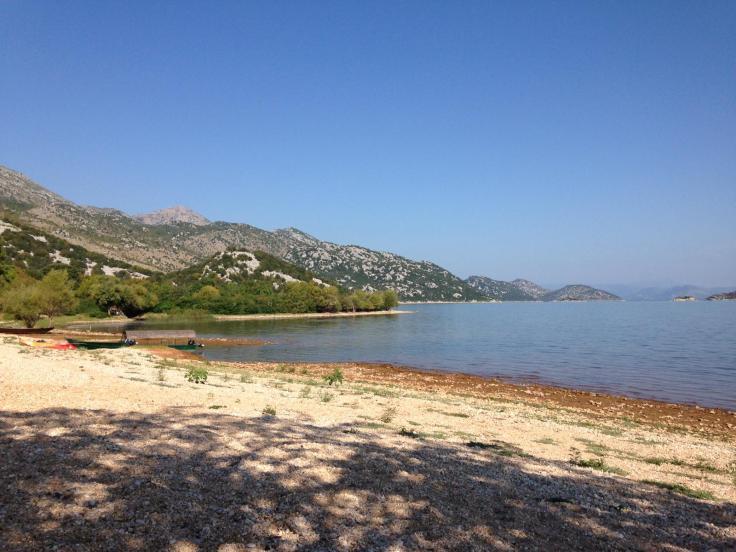
The view on the Albanian Balkans, on the other side of the lake, is stunning. While going on the water, small fishes take immediately care of your feet pedicure, attracted by all the sediments raised when walking in the water.
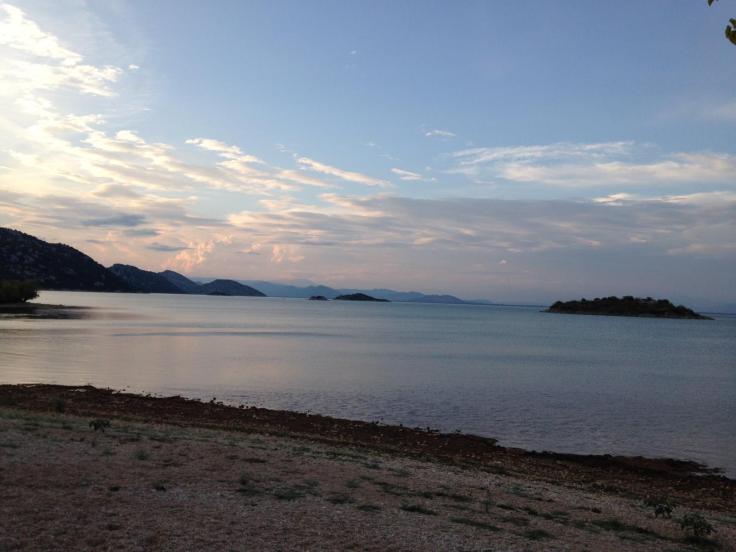
The camping serves fresh fishes, as trouts or carps, just fished. Canoes can also be rented, to visit all the islands in front of the campsite, some of them hosting a Monastery.
The contrast between two religions, the orthodox religion and Islam, is seizing here. Murici is a small village of a few houses, articulated around a Mosque. Conversely, some the islands in front of the village host a Christian monastery, as only construction.
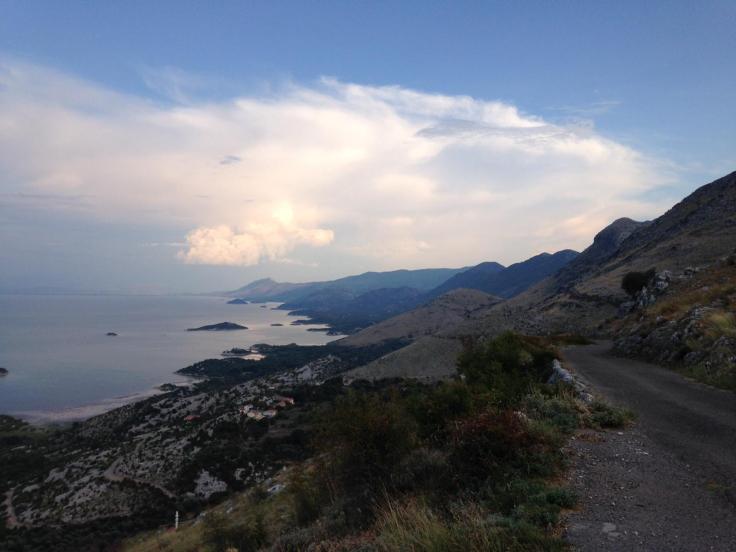
In case you don’t want to stay in the camping, you can also pitch your tent in one of the beaches of the lake. Quietness guaranteed.
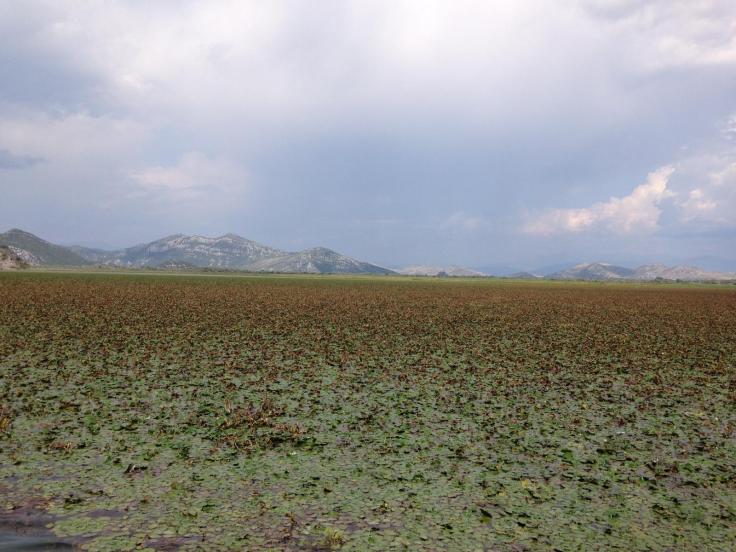
One of the most famous views of Montenegro is the view on the river leading to Skadar Lake. The site is absolutely not indicated from the main roads, and the path to get until there is very narrow and steep.

But the view is definitely speechless, and you will most likely be alone when going there. You can access the place from the road from Podgorica to Cetinje. Turn on the small road where it mentions “Rijeka Crnojevica”. From there, leave the car and walk until you discover the view.
Have fun 🙂

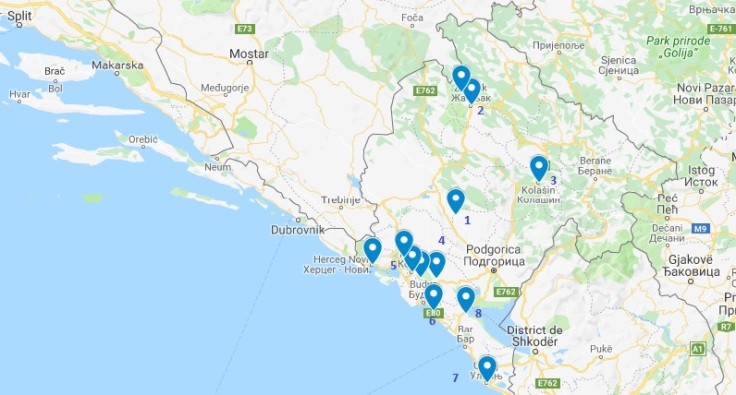
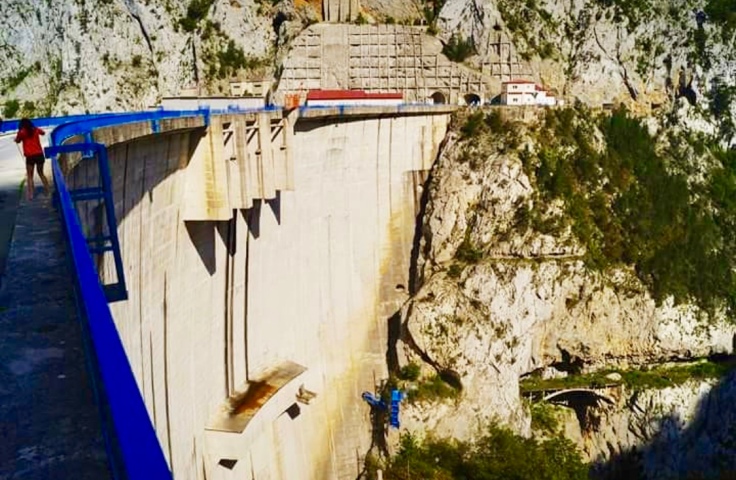
Leave a comment